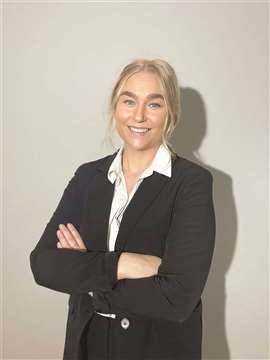4 women leading the charge in industry
08 March 2024
Equipment rental and related fields like construction and engineering are not traditionally thought of as particularly welcoming to women. That’s changing, but there’s still a long way to go to ensure equity in the workplace for women and minorities. In celebration of International Women’s Day on March 8, we take a look at the past 12 months with a selection of features that highlight the efforts being made by women for people everywhere.
International Women’s Day is Friday, March 8, and is meant to be a day focused on gender equality with goals focused on creating a world that is diverse, equitable and inclusive.
In celebration of women’s achievements, International Women’s Day hopes to collectively #InspireInclusion and raise awareness of discrimination.
With that in mind, here are four women who’ve been working to further the cause within construction, engineering and adjacent industries such as equipment rental. Read on for details and click on the subheads for the full stories.
Renta Group’s Rebecca Långström tackles Scope 3 emissions
 Rebecca Långström, head of sustainability, Renta Group. (Photo: Renta Group)
Rebecca Långström, head of sustainability, Renta Group. (Photo: Renta Group)
Nordic-based Renta Group appointed Rebecca Långström as its first-ever head of sustainability in September 2023. Since then, she’s been tackling the skills shortage and rental’s role in construction’s sustainable future.
Just one of the areas of her focus is reducing Scope 3 emissions. Långström, former quality and environmental coordinator for Atlas Copco, says the company is “very humbled for the challenge” of Scope 3.
“For Scope 1 and 2, we have very good knowledge, but for Scope 3 the biggest challenges will be in the supply chain, especially transportation and manufacture and use of the products,” she says.
“There’s also many different suppliers and stakeholders involved, so we have tried to prepare our suppliers to begin somewhere.
“All countries got a text from me on what type of questions they could start to ask, such as are they covered by CSRD? Also, more concrete action questions like, can you report C02 emissions on your transportations? Do you know the origin of all your metals in the machines?
“We are very humbled and transparent that we will have challenges to collect all the data and we are very much depending on our suppliers for this, as well as our customers will be depending on us to deliver the data. We have to cooperate a lot more than we have done before.”
She also says the size of suppliers will pose a challenge, with bigger suppliers having the benefit of more resources and time to deliver data, while its smaller customers will have to “try and balance data with how much resources they have.”
Of course, investment in fleet will be key in how successful the company is in meeting the Scope 3 challenge. Looking back, Renta invested €132 million on its fleet in 2022, placing it among the top 25 globally according to the IRN100. In 2021 the company also added its first fully electric wheel loaders
While this is an indication that the company isn’t content with its growth trajectory, will future fleet investment also reflect its increasing focus on sustainability?
“We are continuously looking into more green machines with battery or electricity but also keeping our eyes open for hydrogen solutions that the suppliers are developing,” Långström says.
“We have recently hired a fleet director who will be responsible for purchasing for the Group and I will work a lot with him to try to get a better view on how we can cooperate between the countries because we work with the same suppliers in different countries.”
Speedy Hire’s ESG Director Amelia Woodley on achieving net zero
 Amelia Woodley, ESG director. (Photo: Speedy Hire)
Amelia Woodley, ESG director. (Photo: Speedy Hire)
In 2023, UK-based Speedy Hire published a net-zero roadmap that outlined how it aims to achieve net-zero across all scopes by 2040. Amelia Woodley, ESG director, talks about the progress being made by the company.
Speedy Hire launched its ambitious ‘Decade to Deliver’ Net Zero roadmap last year. Woodley says within this strategy, the company devised clear, science-based targets with tangible steps to reach Net Zero by 2040, 10 years ahead of the government deadline.
“We aim to reduce Scope 1 & 2 emissions by 50% and Scope 3 emissions by 42% by 2030,” she says, listing some of Speedy’s long- and short-term goals to help reach those targets:
- Replace 100% of petrol and diesel cars within our fleet with electric vehicles (EVs). Transition 66% of diesel vans and 15% of UK-based HGVs to EVs and transition a further 25% of UK-based vans and HGVs to low carbon alternatives like HVO
- Reduce refrigerant leakage by 14% and natural gas emissions by 30%
- Operate on 100% renewable electricity by FY2027 in the UK and Ireland
- Reduce the amount of fossil fuel driven equipment hired to customers by 49%, including an 18% reduction in sold fossil fuels such as petrol, a 68% reduction in sold diesel and a 17% reduction in sold propane
- Utilise policy, engagement and booking process to reduce travel on economy flights by 40%, reduce hotel use by 35% and car use by 45% by encouraging the use of online capability and rail transport/EVs from hire car providers
- Reduce waste by 2% YOY from FY2023 through staff engagement initiatives
- Work closely with our top 30 suppliers to help set their own science-based targets
To achieve its formidable goals, the company has worked with each unit of the business to develop bespoke plans that address their specific needs to reach these goals. It evaluated which of the targets are most relevant to the different divisions.
“Our team members also need the right skills and competencies,” Woodley says. “To support the team, in addition to company-wide sustainability training, we offer tailored training programs which cater towards the particular needs of each team. For example, executive training for our Board of Directors.
“We also implemented the first-ever Sustainable Business Partner Program in partnership with IEMA to train 30 employees, transforming their jobs into green roles to future proof the workforce and ensure delivery of our key targets.”
Woodley says on an operational level, Speedy has introduced new platforms to assist with the digitization of data sets, particularly for Scope 3 emissions.
“As we are now working with larger datasets than previously, this technology will support us in developing insights and address the key issues of the business,” she says. “This is heavily focused around the supply chain and we are working with suppliers in terms of digital onboarding and digitization of ESG questionnaires to assess maturity.”
Story Contracting Managing Director Emma Porter fights for diversity and inclusion
 Emma Porter, managing director of Story Contracting. (Photo: Story Contracting)
Emma Porter, managing director of Story Contracting. (Photo: Story Contracting)
Spurred on by the #MeToo movement and #BlackLivesMatter, construction and rental companies have been among those rushing to introduce and upgrade Diversity & Inclusion programs. Emma Porter, managing director of UK-based Story Contracting explains how her company is working to become a more welcoming workplace.
When she started working in the plant hire business, Emma Porter noticed that many staff were being asked to start work at seven in the morning without any apparent reason.
“The plant hire division started out providing internal plan to the wider Story Contracting company and so that meant that the teams needed to be in first thing in the morning because they were preparing the machines for the day, which made sense,” recalls Porter, now managing director of UK-based contractor Story Contracting.
But as the company grew and diversified to become an external plant hire firm, staff contracts continued to contain a 6.30 am start time, even though there was no practical business case for them to do so.
“We didn’t really need to be in at 6:30 am or 7 am - but it was just decided that was the start time. And so, for years that was the start time in people’s contracts,” she says. “But if you’ve got young children that you need to drop off at childcare in the morning, nurseries are not open at six thirty in the morning. And so, we, for no business reason at this point, had a barrier that really restricted the people who could apply for that work.”
For Porter, who also runs Story’s plant hire division, Story’s inconvenient start time is just one example of the barrage of ‘microaggressions’ which together form a “horrible black fog of unconscious bias,” which continue to make life harder for women... and which has prompted her company to adopt a new diversity and inclusion program aimed at making the company more welcoming.
“Often when I talk about diversity, I talk about the need for different perspectives, but I’d really missed just how much my perspective meant that I was seeing issues, that others weren’t,” says Porter, addressing an audience at the European Rental Association Convention in Maastricht last summer. “I would be frustrated, thinking, why aren’t they fixing this? This is a problem. But the key reason they were not fixing these problems was because from where they were standing, they didn’t see it.”
Author Lauren Neal on the importance of retaining female employees
 Lauren Neal, author of Valued at Work. (Photo: Lauren Neal)
Lauren Neal, author of Valued at Work. (Photo: Lauren Neal)
“Career deflection” is prompting thousands of women to leave engineering, construction and adjacent industries each year. Valued At Work author Lauren Neal takes a look at how bosses can encourage them to stay.
The first time Lauren Neal seriously considered quitting her job as an engineer was when she tried to highlight to her bosses that she was experiencing a lack of career progression at work.
Having completed a master’s degree in electronic and electrical engineering and with three years in her first job at a firm specializing in real-time monitoring for offshore rotating equipment which had not progressed as she had hoped, she took a new role at a rival, hoping to take on a more technical role working with the heavy equipment.
“You could see on the models that the machinery wasn’t operating as it previously had. I wanted to understand why the readings had dropped. But the view at the time was very much, if it’s not broken don’t fix it. And then, because there wasn’t a lot of work in that space, I ended up sitting on the helpdesk and setting up usernames and passwords,” she says.
“I was working for a guy who openly said that women belong in the kitchen. I always noticed that we didn’t really gel. He told me that if I wanted to learn about equipment, I needed to go back to university and study process engineering and that, with my master’s in electronic and electrical, all I could do was IT.”
A study by the Institute for Employment Studies (IES), sponsored by Atkins, which analyzed UK data sets to assess the numbers of engineers leaving the sector in the decade to 2020, found that in general, women are leaving the profession at twice the rate of men. It found that over the course of a decade, 70% of women employed in engineering left the profession, compared with just 35% of men.
“I’m my opinion, the number one reason why women especially leave the industry is the culture,” says Neal. Some people have said to me it’s the lack of opportunities, but I think there are plenty of opportunities in STEM across the board, it’s whether the culture of the organization makes those opportunities accessible.”
Neal, who went on in 2009 to join a sub-sea engineering team and finally got the hand-on engineering role she was searching for, from which she has gone on to build a career in project management for offshore power projects, hopes that by documenting her struggles and those of other women in the sector in her book Valued at Work, she can do her bit to make it easier for those coming after.
Her main advice for company bosses is to ensure that all employees have a clear, accurate and up-to-date job description to enable each person to see how to progress to where he or she wants to be. Secondly, she advises making time to get to know employees at different levels and not just relying on direct reports.
“It can cost up to 200% of someone’s annual salary to replace them,” Neal adds. “Organizations are losing money due to poor workplace cultures driving great employees out the door.”


